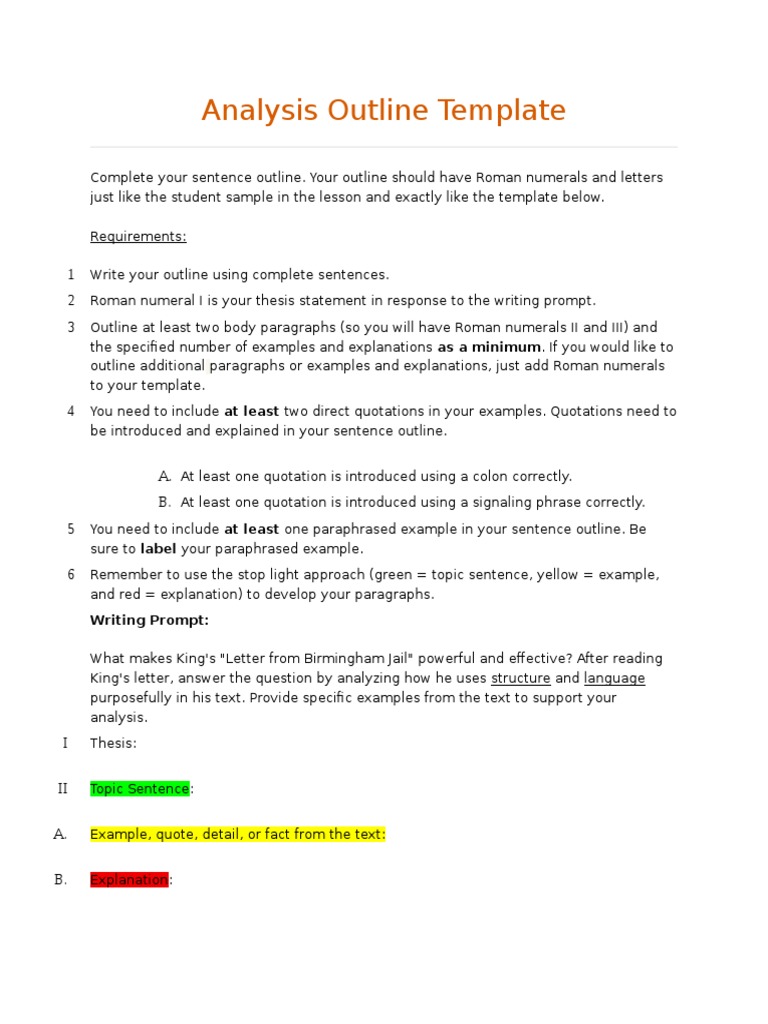
· Textual Analysis. a) of the eleven topics to select from, I have chosen the topic of gendered violence. b) Within this topic, my specific interest is the connection between gender and violence. Across popular forms of media such as gaming, films, television, music and more, violence expresses gender. Gender traits are expressed in media via the gender of the person performing An outline makes your writing readable by logically distributing the information and correctly organizing it. This order of the information helps the writer convince a reader about his stance or claim, which is the primary objective. When writing a literary analysis essay, A Textual Analysis Essay Outline Sample Introduction: Time (place) of writing, history of creation; Genre peculiarity; The place of this poem in the poet's work or a series of poems on a similar theme (with a similar motive, plot, Explanation of unclear places, complex metaphors, and other
Textual Analysis Essays: Examples, Topics, Titles, & Outlines
What Is An Analysis Essay? An analysis is an interpretive process that draws conclusions from a set of facts. Writing an analysis starts by choosing the elements or areas of your topic that you will analyze. You will need to break down the topic, theory, issue or story that you are analyzing into its various pieces or parts. The following are some characteristics of an analysis:.
The following is an analysis outline:. Start your introduction with a hook, followed by the author, title, main characters, a short summary and finally the thesis statement, textual analysis outline. A good introduction has the following features:. The body can be organized in several ways. They include:. Traditional — divide the body into several sections at the same level as the introduction, with names like; data, methods, analysis, results. You should describe the analyses that you have performed.
Question-oriented — there is a single body section in this format called textual analysis outline and then there is a sub-section for each question raised in the introduction, usually taken in the same form as the introduction. For each textual analysis outline statistical method, analyses and conclusions would be described.
Other organizational formats are also possible. Whatever format you choose, it is important to provide one or two well-chosen tables or graphs per question in the body because:. The conclusion should reprise the questions in the introduction. It can also be supplemented by some additional observations and details gathered from the analysis section. Your conclusion should include the following:.
Include one or more appendices to place out the details and additional materials, textual analysis outline. These may include:. It is advisable to add some text sentences such as comments to textual analysis outline it easier for readers to follow what you are doing. The following are some characteristics of an analysis: Makes an argument or reaches a conclusion.
Chooses specific elements to study. Examines and interprets each element. Discusses why each element is important. Discusses how each element connects to the others. Might discuss causes and effects. Might discuss advantages and disadvantages, textual analysis outline. Might discuss effectiveness and ineffectiveness. The following is an analysis outline: 1. Introduction Start your introduction with a hook, followed by the author, title, textual analysis outline, main characters, a short summary and finally the thesis statement.
A good introduction has the following features: Summary of the study and data, as well as any relevant substantive context, background or framing issues. The questions answered by your analysis and summaries of your conclusions about these questions. Brief outline of the remainder of the analysis. Body The body can be organized in several ways. They include: Traditional — divide the body into several sections at the same level as textual analysis outline introduction, with names like; data, methods, analysis, results.
Whatever format you choose, it is important to provide one or two well-chosen tables or graphs per question in the body because: Graphical and tabular displays can convey your points more effectively as compared to words. Your readers will more likely be attracted to a table or graph as compared to plain text. Conclusion The conclusion should reprise the questions in the introduction.
Your conclusion should include the following: Summarize your argument. Extend the argument. Show why the text is important. Appendix Include one or more appendices to place out the details and additional materials.
Textual analysis outline may include: Technical descriptions of statistical procedures. Detailed tables or computer output. Figures that were not central to the arguments presented in the body of the analysis. Computer code used to obtain results.
SELL YOUR OLD PAPERS. Categories Academic Writing 23 Admission Essay Book Summaries 52 College Tips Content Writing Services 1 Essay Help Essay Writing Help 76 Essays Blog 0 Example 26 Infographics 2 Outlines Photo Essay Assignment 4 Resume Writing Tips 62 Samples Essays Writing Jobs 2.
How to Do Literary Analysis (It’s Easy!)
, time: 7:06How To Write A Literary Analysis Essay Outline With Examples

· Textual Analysis Essay Outline. Leave a reply. Essay #2 Outline. Introduction. Line Opener – Some people don’t know what innocence is until they lose it. Thesis Statement – The author’s use of plot, imagery, and symbolism helps tie this poem together to create one big unifying theme about innocence at the end. Body Analysis Outline: Template For Writing An Analytical Essay 1. Introduction. Start your introduction with a hook, followed by the author, title, main characters, a short summary 2. Body. The body can be organized in several ways. Traditional – divide the body into several sections at the A Textual Analysis Essay Outline Sample Introduction: Time (place) of writing, history of creation; Genre peculiarity; The place of this poem in the poet's work or a series of poems on a similar theme (with a similar motive, plot, Explanation of unclear places, complex metaphors, and other
No comments:
Post a Comment